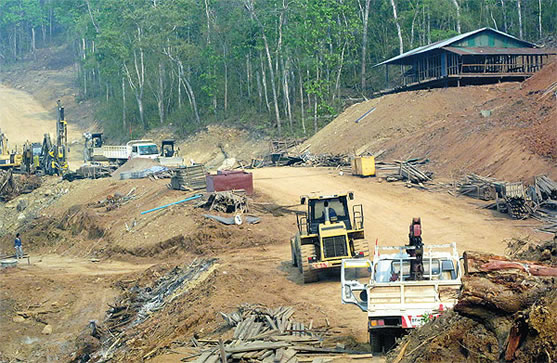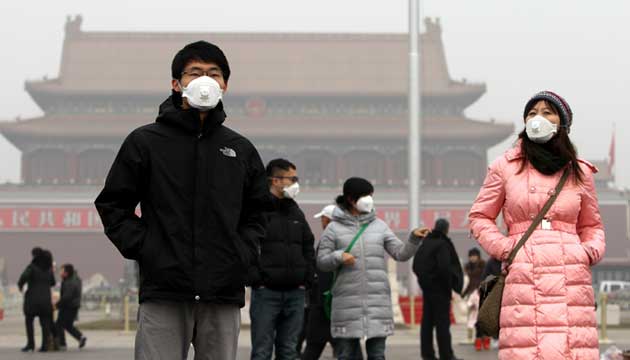
by Deep Green Resistance News Service | Aug 20, 2012 | Biodiversity & Habitat Destruction
By Lawrence Del Gigante / Inter-Press Service
“While each project proposed in Cambodia comes with a different set of impacts, large dams are likely to widen the gap between the rich and the poor, increase malnourishment levels and lead to an environmentally unsustainable future,” Ame Trandem, South East Asia programme director for International Rivers, told IPS.
Four dam projects have been approved so far in Cambodia, with one already operational. All are being developed by Chinese companies on build-operate-transfer agreements, according to Trandem.
The Mekong River runs through six countries, including China and Vietnam, most of which are planning the construction of hydroelectric dams.
“The plans to build a cascade of 11 Mekong mainstream dams is one of the greatest threats currently facing Cambodia,” said Trandem.
The mandate on planning and development of hydropower in Cambodia lies within the ministry of industry, mines and energy, which did not respond to requests for comment.
Another danger of damming the Mekong is the threat to the Mekong delta, an extremely fertile area of land which is responsible for much of the region’s rice supply.
“As the Mekong River feeds and employs millions of people in the region for free, it would be irresponsible to proceed with the Xayaburi and other mainstream dams,” said Trandem.
The Mekong is one of the only rivers in the world to reverse its flow in the dry season. This natural mechanism buffers the intrusion of salt water from the South China Sea into the delta, and could be upset by upstream development.
Dams also block fish migration routes, alter flows, and change aquatic habitats, so these projects are also likely to have an adverse effect on Cambodia’s fisheries.
“The Mekong River Commission’s Strategic Environmental Assessment warned that more than one million fisheries-dependent people in Cambodia would lose their livelihoods and even more would suffer from food insecurity,” said Trandem.
“The loss of even a small percentage of the Mekong’s fisheries can represent in a loss of tens of millions of dollars.”
Partnerships have been established between the countries through which the Mekong runs in order to prevent overharvesting of the river’s resources. However, China is not a signatory to the 1995 Mekong Agreement, and can effectively build these projects independently from downstream countries. The dams in Cambodia are being financed by Chinese investors.
“The impacts of these projects are already being felt downstream,” said Trandem.
Hydroelectricity, even if a successful venture, will not solve the country’s electrification problems, other analysts say.
“Right now it is relatively catastrophic, the power situation in the country,” Alexander Ochs, the director of climate and energy at the Washington-based Worldwatch Institute, told IPS.
Cambodia has one of the lowest electrification rates in Southeast Asia, estimated at only 24 percent, according to the Asian Development Bank (ADB).
The government aims to raise the national electrification rate to 70 percent by 2020, according to the ADB, by expanding the grid and sourcing more than half of the needed electricity from the Mekong River.
A large complication is transmitting the electricity, with only the major cities and surrounding areas having access to power lines, meaning people in rural areas will not benefit from the hydro.
“The number of people that are really connected to a grid as we know it, a modern power service or energy line, in rural areas is as little as seven percent of the population. Overall, nationwide, it’s about 15 percent,” said Ochs.
Read more from Inter-Press Service: http://www.ipsnews.net/2012/08/cambodias-hydro-plans-carry-steep-costs/
by Deep Green Resistance News Service | Aug 7, 2012 | Mining & Drilling, Toxification
By Le Monde
From the air it looks like a huge lake, fed by many tributaries, but on the ground it turns out to be a murky expanse of water, in which no fish or algae can survive. The shore is coated with a black crust, so thick you can walk on it. Into this huge, 10 sq km tailings pond nearby factories discharge water loaded with chemicals used to process the 17 most sought after minerals in the world, collectively known as rare earths.
The town of Baotou, in Inner Mongolia, is the largest Chinese source of these strategic elements, essential to advanced technology, from smartphones to GPS receivers, but also to wind farms and, above all, electric cars. The minerals are mined at Bayan Obo, 120km farther north, then brought to Baotou for processing.
The concentration of rare earths in the ore is very low, so they must be separated and purified, using hydro-metallurgical techniques and acid baths. China accounts for 97% of global output of these precious substances, with two-thirds produced in Baotou.
The foul waters of the tailings pond contain all sorts of toxic chemicals, but also radioactive elements such as thorium which, if ingested, cause cancers of the pancreas and lungs, and leukaemia. “Before the factories were built, there were just fields here as far as the eye can see. In the place of this radioactive sludge, there were watermelons, aubergines and tomatoes,” says Li Guirong with a sigh.
It was in 1958 – when he was 10 – that a state-owned concern, the Baotou Iron and Steel company (Baogang), started producing rare-earth minerals. The lake appeared at that time. “To begin with we didn’t notice the pollution it was causing. How could we have known?” As secretary general of the local branch of the Communist party, he is one of the few residents who dares to speak out.
Towards the end of the 1980s, Li explains, crops in nearby villages started to fail: “Plants grew badly. They would flower all right, but sometimes there was no fruit or they were small or smelt awful.” Ten years later the villagers had to accept that vegetables simply would not grow any longer. In the village of Xinguang Sancun – much as in all those near the Baotou factories – farmers let some fields run wild and stopped planting anything but wheat and corn.
A study by the municipal environmental protection agency showed that rare-earth minerals were the source of their problems. The minerals themselves caused pollution, but also the dozens of new factories that had sprung up around the processing facilities and a fossil-fuel power station feeding Baotou’s new industrial fabric. Residents of what was now known as the “rare-earth capital of the world” were inhaling solvent vapour, particularly sulphuric acid, as well as coal dust, clearly visible in the air between houses.
Read more from The Guardian: http://www.guardian.co.uk/environment/2012/aug/07/china-rare-earth-village-pollution

by Deep Green Resistance News Service | Aug 2, 2012 | Biodiversity & Habitat Destruction, Mining & Drilling
By Jeremy Hance / Mongabay
Burning coal fuels climate change, causes acid rain, and spreads toxic pollutants into the environment, but now a new Greenpeace report warns that coal may also imperil the world’s biggest feline: the tiger. Home to world’s largest population of tigers—in this case the Bengal subspecies (Panthera tigris tigris)—India is also the world’s third largest coal producer. The country’s rapacious pursuit of coal—it has nearly doubled production since 2007—has pushed the industry into tiger territory, threatening to destroy forests and fragment the tiger’s already threatened population.
“Unfortunately for the tiger, its largest contiguous habitat—Central India—is also where most of India’s coal lies,” Ashish Fernandes, author of the report, told mongabay.com.
India is one of the bright spots in the global effort to save the tiger from extinction. The country now holds around 1,700 tigers, over half of the world’s population of wild tigers. Although India’s tiger population is generally considered to be in decline, there have been some local population increases giving hope that the country can turn around the situation. Yet the tiger still faces poaching and habitat loss, the latter which is likely to be exacerbated by open pit mining for coal.
“Several of India’s largest coalfields (such as Singrauli and Talcher) include forest areas adjoining Tiger Reserves, and where tigers are found. Coal mines are already eating into these areas, and with the ongoing expansion, this will worsen,” Fernandes says.The Bengal tiger, which is considered Endangered by the IUCN Red List, is the undisputed king in these forests, which in some cases also sports populations of leopard (Panthera pardus), Near Threatened; Asian elephant (Elephas maximus), Endangered; sloth bear, (Melursus ursinus), Vulnerable; sambar (Rusa unicolor), Vulnerable; and other non-threatened deer and antelope species.
Analyzes 13 Central Indian coal mines, in various stages of exploitation, the report finds that full open pit mining in these areas would destroy over a million hectares of forest. According to official data, 18 percent of these forests are known to be used by tigers, 27 percent by leopards, and 5.5 percent by elephants. In all, eight of India’s renowned Tiger Reserves will be impacted, potentially harming around 230 tigers or 13 percent of India’s total tiger population.
“India’s Protected Areas/Tiger Reserves are small by global standards, with few larger than 500 square kilometers. As such, if isolated, their tiger populations are not viable in the long term,” Fernandes explains. “Tigers, males in particular, roam large areas in search of mates, and this ensures genetic vibrancy. As young tigers mature, they also need to establish their own territories, or face conflict with dominant males. Corridors help aid this dispersal and ensure a healthy gene flow between different ‘source’ tiger populations.”
India is a signatory of an ambitious conservation plan to double wild tiger populations worldwide by 2022, a plan which was endorsed by all 13 tiger countries in 2010. Worldwide, tigers have been decimated by habitat loss, prey depletion, and hunting, now largely to feed the Chinese medicine trade. The great cats have been left with about 7 percent of their historical range, and already three subspecies have vanished for good.

by Deep Green Resistance News Service | Aug 1, 2012 | Toxification
By European Geosciences Union
Most of the world’s population will be subject to degraded air quality in 2050 if man-made emissions continue as usual. In this ‘business-as-usual’ scenario, the average world citizen 40 years from now will experience similar air pollution to that of today’s average East Asian citizen. These conclusions are those of a study published today in Atmospheric Chemistry and Physics, an Open Access journal of the European Geosciences Union (EGU).
Air pollution is a major health risk that may worsen with increasing industrial activity. At present, urban outdoor air pollution causes 1.3 million estimated deaths per year worldwide, according to the World Health Organisation.
“Strong actions and further effective legislation are essential to avoid the drastic deterioration of air quality, which can have severe effects on human health,” concludes the team of scientists, led by Andrea Pozzer of the Abdus Salam International Centre for Theoretical Physics in Italy (now at the Max Planck Institute of Chemistry in Germany), in the new paper.
The researchers studied the impact of man-made emissions on air quality, assuming past emission trends continue and no additional climate change and air pollution reduction measures (beyond what is in place since 2005) are implemented. They point out that, while pessimistic, the global emissions trends indicate such continuation.
“At present the post-Kyoto climate negotiations are progressing slowly, and it is unclear how air quality policies will develop globally,” explains co-author Greet Janssens-Maenhout of the European Commission Joint Research Centre in Italy. “In regions with economic growth, it might be less effective to implement emission-reduction measures due to strong growth in activities in particular sectors; in countries suffering from the economic downturn, implementing expensive air-quality measures could prove difficult in coming years,” she adds.
“We show that further legislation to control and reduce man-made emissions is needed, in particular for eastern China and northern India, to avoid hot-spots of elevated air pollution,” says Pozzer. Combined with the fact that these are regions of high population density, elevated air pollution here would mean that air quality would worsen significantly for the average world citizen in 2050.
Air pollution would also increase in Europe and North America, but to a much lesser extent than in Asia, due to the effect of mitigation policies that have been in place for over two decades.
Pozzer and his colleagues estimated air quality in 2005, 2010, 2025 and 2050 using an atmospheric chemistry model. “The model uses basic mathematical formulation to predict the meteorology and the chemical composition of the atmosphere,” Pozzer explains. “In practice, it is a software used to forecast – or hindcast, for past years – the status of the atmosphere at specific times.”
The results show that in 2025 and 2050, under the business-as-usual scenario studied, East Asia will be exposed to high levels of pollutants, such as nitrogen dioxide, sulphur dioxide and fine particulate matter (PM2.5). Northern India and the Arabian Gulf region, on the other hand, will suffer a marked increase in ozone levels.
The analysis now published is the first to include all five major air pollutants know to negatively impact human health: PM2.5, nitrogen dioxide, sulphur dioxide, ozone, and carbon monoxide. The scientists considered pollutants released through human activity, as well as those occurring naturally such as desert dust, sea spray, or volcanic emissions.
Taking all pollutants into account, eastern China, northern India, the Middle East, and North Africa are projected to have the world’s poorest air quality in the future. In the latter locations this is due to a combination of natural desert dust and man-induced ozone. The effect of anthropogenic pollution emissions are predicted to be most harmful in East and South Asia, where air pollution is projected to triple compared to current levels.
The study aimed to compare the influence of man-made emissions on air quality in different regions, and show how no-further legislation to reduce emissions can result in drastic deterioration of air quality worldwide compared to the present day situation.
From European Geosciences Union: http://www.egu.eu/news/36/cut-emissions-further-or-face-risks-of-high-air-pollution-study-shows/

by Deep Green Resistance News Service | Jul 28, 2012 | Defensive Violence, NEWS, Obstruction & Occupation, Property & Material Destruction, Toxification
By Shiv Malik for The Guardian
Officials in eastern China have cancelled a planned industrial waste pipeline project after up to 1,000 environmental demonstrators occupied a government office, overturned cars, destroyed computers and beat police officers.
The demonstration in the city of Qidong was the latest in a string of protests sparked by fears of environmental degradation.
Zhang Guohua, mayor of the eastern city of Nantong, announced the cancellation of the pipeline, which would have emptied waste water from a Japanese-owned paper factory via the coastal town of Qidong into the sea. It is the second industrial project to be cancelled in a month.
The decision came hours after about 1,000 protesters marched through the city of Qidong, about one hour north of Shanghai, shouting slogans against the pipeline.
Several protesters entered the city government’s main building and were seen smashing computers, overturning desks and throwing documents out of the windows to loud cheers from the crowd. Five cars and one minibus were also upended, according to Reuters reporters at the scene.
At least two police officers were dragged into the crowd at the government office and punched and beaten bloody.
Environmental worries have stoked calls for expanded rights for citizens and greater consultation in the tightly controlled one-party state and come before a once-in-a-decade leadership transition this year.
The protest followed similar demonstrations against projects in the Sichuan town of Shifang earlier this month and in the cities of Dalian in the north-east and Haimen in southern Guangdong province in the past year.
The government in Shifang halted a multimillion-pound copper alloy plant project because it said there was insufficient public understanding and support after teargas was used to disperse protesters.
The Chinese government has vowed to clean up China’s skies and waterways and increasingly tried to appear responsive to complaints about pollution.
But environmental disputes pit citizens against local officials, whose aim is to lure fresh investment and revenue into their areas.
From The Guardian
Photo by Yiran Ding on Unsplash




